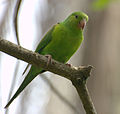| Brotogeris | |
|---|---|
 | |
| Plain parakeet | |
| Scientific classification | |
| Kingdom: | Animalia |
| Phylum: | Chordata |
| Class: | Aves |
| Order: | Psittaciformes |
| Family: | Psittacidae |
| Subfamily: | Arinae |
| Genus: | Brotogeris Vigors, 1825 |
| Type species | |
| Psittacus pyrrhopterus (grey-cheeked parakeet) Latham, 1801 | |
| Species | |
see text | |
Brotogeris is a genus of small parrots endemic to Central and South America. Their closest relatives are the monk parakeet and the cliff parakeet in the genus Myiopsitta . They eat seeds and fruit. [1] The word brotogeris means "having the voice of a human". In the language of their native countries, which is mostly Spanish, they are called pericos – the translation of which is "parakeet". Their average lifespan is 15 years, although some have been reported to have lived up to 35 years. Also, the bird was found in Rio Grande do Sul in South America.[ citation needed ]











